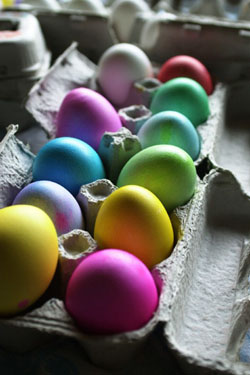Atoms Incognito

As with people, some atoms prefer to join in groups, while others insist on going it alone. But when prodded with laser light, inherently gregarious atoms known as bosons can act like loner atoms known as fermions, a duo of theoretical physicists predict in the 18 April PRL. The faux-loner atoms can even form tenuous pairs, much like the electrons in a superconductor, so that they resemble a long-sought new state of matter.
The level of sociability for atoms and subatomic particles depends on how much spin they have. Atoms and subatomic particles with integer amounts of spin are known as bosons, and according to quantum mechanics, identical bosons prefer to snuggle into a single quantum state at low temperatures. Researchers first observed such chumminess, called Bose-Einstein condensation, in ultra-cold atoms in 1995.
All other atoms and particles have spins equal to an integer plus an extra half. Such particles are called fermions, and quantum mechanics forbids identical fermions from occupying the same quantum state. This “exclusion principle” explains why electrons, which have spin 1/2, stack themselves into distinct energy levels in atoms. At very low temperatures, however, the electrons in superconductors form tenuous pairs–like two shy people circling each other at a distance–which glide through the metal without resistance. Atomic physicists hope to observe similar pairing in a gas, which would constitute a new state of matter, but so far no one has succeeded in making a gas of fermionic atoms cold enough.
Ironically, the easiest way to spot such fermionic pairing in atoms may be to study bosons, report Belén Paredes and Ignacio Cirac of the Max Planck Institute for Quantum Optics in Garching, Germany. In an atomic Bose-Einstein condensate, the atoms rarely approach one another closely, but when bosonic atoms interact, they can mimic fermions. For example, in confined quarters the atoms act not like infinitesimal points, but like little billiard balls, and it becomes impossible to cram two of them into the same small volume. That effect mimics the exclusion principle, as researchers have reported in the past. Now, Paredes and Cirac have devised a scheme to observe pairing among bosons, too.
The theorists envision spreading atoms in a corrugated field of laser light known as an optical lattice. The light field acts a bit like an egg carton for atoms, which settle in the low spots. If the dips in the laser field are very narrow and deep, then only one atom will fit into each dip, and they will effectively act like fermions.
The researchers then envision superimposing a second optical lattice filled with atoms of the same element whose electrons are arranged in a slightly different quantum state. Atoms in the two different states can attract one another by slightly polarizing each other–the so-called van der Waals force. With the proper choices of atoms and states, atoms in one state can pair with those in the other, Paredes and Cirac calculate, just as spin-up electrons pair with spin-down electrons in a superconductor. And just as in a superconductor, these pairs will be widely spaced, so that the two atoms in a pair may be separated by several lattices spacings. Thus, the bosons will have pulled off the ultimate fermion stunt.
The scheme could open intriguing opportunities to study fermionic behavior with more manageable bosonic atoms, says Theodor Hänsch, an experimentalist at the University of Munich and the Max Planck Institute for Quantum Optics. Making the scheme work may not be easy, Hänsch says, “but progress is rapid, so sooner or later somebody will do an experiment that will see these effects.”
–Adrian Cho
Adrian Cho is a freelance science writer in Grosse Pointe Woods, Michigan.


